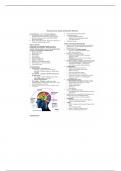Trauma, Stressor-related, & Dissociative Disorders
Course Objectives: 1, 2, 3, 5, 6 Lecture Objectives: Posttraumatic Stress Disorder (PTSD)
Discuss characteristics, risk factors, & dynamics of Attachment Disorders
immediate & long-term individual responses to trauma o Reactive attachment disorder
Describe responses to trauma – specifically PTSD & o Disinhibited social engagement disorder
Dissociative disorders o Acute Stress Disorder
Identify nursing interventions, treatments, & education of Adjustment Disorders
clients experiencing trauma reactions
PTSD – Post Traumatic Stress Disorder
What is a Trauma? Exposure to actual or threatened death, serious injury, or
Events in life – extraordinary intensity or severity – sexual violence – person responded with intense fear,
beyond stress of everyday life – Person perceives as helplessness, or horror
harmful or life threatening - causes severe emotional shock Can be brought on by indirect exposure
& may have long lasting psychological effects o loved one or friend experienced the trauma
Military trauma / War o EMS / Police /ED nurses
Sexual abuse / Rape Persistent re-experiencing of event
Physical abuse o Recurrent, involuntary, intrusive distressing
Severe neglect
memories of events
Emotional abuse
o Flashbacks: feels or acts as if event recurring -
Repeated abandonment
Physical sensations of terror
Sudden or traumatic loss
Persistent avoidance of stimuli associated with trauma
Diagnosis of a life-threatening illness
Natural disasters or man-made disaster o Avoid distressing memories, thoughts, feelings
o Avoid external reminders – people, places,
Crime related events
conversations, activities, objects, situations
The Trauma Brain: Cognition Issues:
Thinking Brain – Prefrontal Cortex o inability to recall aspects of trauma
o Personality, decisions, memory, information o Negative beliefs of self, others, world
processing – translator of emotion – should control o Blame self or others
amygdala o Fear, horror, anger, guilt, shame
Survival Brain – Amygdala - Mid Brain & Brain Stem o Decreased interest in usual activities
& Limbic System o Feelings of detachment, estrangement from others
o Our autopilot – breathe, heartbeat, digest food & o Restriction in feelings – can’t feel happiness,
Fight –Flight- Freeze – FASTER satisfaction, love
o Trauma – hyperactivates Arousal & Reactivity Issues:
The Mediator – Thalamus - receives all sensory o Hypervigilance & Exaggerated startle response
information (sights, sounds, smells, tastes, touch) – relays o Persistent high levels of anxiety or arousal
to both thinking & survival brain o Irritable / angry outbursts
Traumatized brain perceives presence of danger almost o Trouble concentrating
everywhere o Sleep issues
o Guilt common
May have dissociative symptoms
o Generalized numbing – feeling detached from others,
empty inside
Significant distress or impairment in functioning, trust a
common issue, sense of foreshortened future
o Often present for care of somatic symptoms
Comorbidity:
o Depression, substance abuse, anger & aggressive
behavior, & relationship problems
Timing:
o PTSD = Symptoms must be present for greater than 1
month
o Acute =lasting<3 months.
o Chronic = lasting for 3 months or more
o Delayed =onset 6 months after event
Trauma Disorders:
, Attachment Disorders
>100% of Reactive Attachment Disorder
children who o Inhibited – emotionally withdrawn behavior
witness parent’s o Does not seek comfort when distressed
murder or o Cause: Lack of bonding with primary caregiver by
sexual assault age 8 mts
will have PTSD Disinhibited social engagement disorder
>Sexually o Remarkably friendly & confident
Abused o No normal fear of strangers
Children – o No normal boundaries with those not known
90% o Unfazed by separation with adult caregivers –
>Exposed attaching to everyone yet not really attaching to
to a school
anyone
shooting –
77%
Risk Factors – Childhood PTSD
PTSD: Why Genetic
o Prenatal exposure to maternal stress
The Experience:
o Severity & duration – Altered DNA in brain – methylation – control
production of stress hormone – prevents brain
o Extent of preparation
from governing response to stress
o Exposure to death; # affected
o Protective = parental nurturing
o Control over recurrence o Absence of nurturing = increased high-risk behavior
o Location (familiar environment; home; foreign
as teens – aggression, impulsivity, weakened
country) cognition, inability to discriminate between real &
The Recovery Environment: imagined threats as adults
o Social support, cohesive & protective family / friends Neurobiological
o Attitudes of society / cultural influences o < age 5
The Person: o Trauma disrupts integration of neuronal networks in
o Coping resources limbic system
o Preexisting psychopathology o Brain will dissociate
o Outcomes from prior stress / trauma – Disconnection of thoughts, emotions, sensations,
o Temperament & behavior – connected with the memory
o Psychosocial development stage – When this fails = intrusive symptoms
o Demographics (flashbacks)
o Childhood Trauma? Psychological Factors
o Attachment Theory
Ego Defense Mechanisms Used in PTSD: – Early relationship infant – caretaker
Isolation – Schemas – formed early
o Splitting off of emotional components of a thought Environmental Factors
– May be temporary or long term o Neuroplasticity – experiences reorganize neural
Repression pathways
o Involuntary exclusion of a painful or conflictual o Parent models behaviors
thought, impulse, or memory from awareness o Cushion Effect:
– Family stability
PTSD in children- pg. 296
Assessment: Adverse Childhood Experiences “The ACE Effect”
o Reduced play Change neurobiological, epigenetic, & adaptive stress
o Repetitive play – includes aspects of event hormone responses in developing brain
o Social withdrawal Allostatic overload of nervous system = exaggerated
o Negative emotions – fear, guilt, anger, horror, inflammatory responses
sadness, shame, confusion o Constant stimulation of hypothalamic-pituitary-
o Negative thoughts of self – “bad person” adrenal axis
o Detachment / estrangement from others o Can Change DNA – increased risk for cancer!
o Irritable, aggressive, self-destructive behavior Lifestyle Clusters = increased risk for chronic disease &
o Sleep disturbance, problems concentrating, premature death
hypervigilance Score of 4 or > = linked to risk factors:
Nursing Diagnosis: o Tobacco abuse / Substance abuse & addiction -
o Risk for developmental delay increased relapse
o Risk for impaired attachment o Obesity
o Sedentary lifestyle
o Depression




